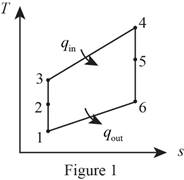
a)
The pressure at the turbine exit.
a)
Answer to Problem 133P
The pressure at the turbine exit is
Explanation of Solution
Draw the

Consider that the aircraft is stationary, and the velocity of air moving towards the aircraft is
Diffuser (For process 1-2):
Write the expression for the energy balance equation for the diffuser.
Here, the rate of energy entering the system is
Write the temperature and pressure relation for the process 1-2.
Here, the specific heat ratio of air is k, pressure at state 1 is
Compressor (For process 2-3)
Write the pressure relation using the pressure ratio for the process 2-3.
Here, the pressure ratio is
Write the temperature and pressure relation for the process 2-3.
Here, temperate at state 3 is
Turbine (For process 4-5)
Write the temperature relation for the compressor and turbine.
Here, the specific heat at constant pressure is
Write the temperature and pressure relation for the process 4-5.
Conclusion:
From Table A-2E, “Ideal-gas specific heats of various common gases”, obtain the following values for air at room temperature.
The rate of change in the energy of the system
Substitute
Here, inlet velocity is
Substitute 0 for
Substitute
Substitute 13 for
Substitute 537.4 R for
Substitute
Substitute
Thus, the pressure at the turbine exit is
b)
The exit velocity of the exhaust gases.
b)
Answer to Problem 133P
The exit velocity of the exhaust gases is
Explanation of Solution
Nozzle (For process 5-6)
Write the temperature and pressure relation for the isentropic process 4-6.
Here, pressure at state 6 is
Write the energy balance equation for the nozzle.
Conclusion:
Substitute
The rate of change in the energy of the system
Substitute
Here, velocity at stat 5 is
Since,
Substitute
Thus, the exit velocity of the exhaust gases is
c)
The propulsive efficiency of the turbojet engine.
c)
Answer to Problem 133P
The propulsive efficiency of the turbojet engine is
Explanation of Solution
Write the expression to calculate the propulsive work done per unit mass by the turbojet engine
Here, the velocity of the aircraft is
Write the expression to calculate the heating value of the fuel per unit mass for the turbojet engine
Here, temperature at state 4 is
Write the expression to calculate the propulsive efficiency of the turbojet engine
Conclusion.
Substitute
Substitute
Substitute
Thus, the propulsive efficiency of the turbojet engine is
Want to see more full solutions like this?
Chapter 9 Solutions
CONNECT FOR THERMODYNAMICS: AN ENGINEERI
- please solve this problems follow what the question are asking to do please show me step by steparrow_forwardplease first write the line action find the forces and them solve the problem step by steparrow_forwardplease solve this problem what the problem are asking to solve please explain step by step and give me the correct answerarrow_forward
- please help me to solve this problem step by steparrow_forwardplease help me to solve this problem and determine the stress for each point i like to be explained step by step with the correct answerarrow_forwardplease solve this problem for me the best way that you can explained to solve please show me the step how to solvearrow_forward
- plese solbe this problem and give the correct answer solve step by step find the forces and line actionarrow_forwardplease help me to solve this problems first write the line of action and them find the forces {fx=0: fy=0: mz=0: and them draw the shear and bending moment diagram. please explain step by steparrow_forwardplease solve this problem step by step like human and give correct answer step by steparrow_forward
- PROBLEM 11: Determine the force, P, that must be exerted on the handles of the bolt cutter. (A) 7.5 N (B) 30.0 N (C) 52.5 N (D) 300 N (E) 325 N .B X 3 cm E 40 cm cm F = 1000 N 10 cm 3 cm boltarrow_forwardUsing the moment-area theorems, determine a) the rotation at A, b) the deflection at L/2, c) the deflection at L/4. (Hint: Use symmetry for Part a (θA= - θB, or θC=0), Use the rotation at A for Parts b and c. Note that all deformations in the scope of our topics are small deformation and for small θ, sinθ=θ).arrow_forwardDistilled water is being cooled by a 20% propylene glycol solution in a 1-1/U counter flow plate and frame heat exchanger. The water enters the heat exchanger at 50°F at a flow rate of 86,000 lbm/h. For safety reasons, the water outlet temperature should never be colder than 35°F. The propylene glycol solution enters the heat exchanger at 28°F with a flow rate of 73,000 lbm/h. The port distances on the heat exchanger are Lv = 35 in and Lh = 18 in. The plate width is Lw = 21.5 2 in. The plate thickness is 0.04 in with a plate pitch of 0.12 in. The chevron angle is 30° and the plate enlargement factor is 1.17. All ports have a 2 in diameter. The fouling factor of the propylene glycol solution can be estimated as 2 ×10−5 h-ft2-°F/Btu. a. Determine the maximum number of plates the heat exchanger can have while ensuring that the water outlet temperature never drops below 35°F. b. Determine the thermal and hydraulic performance of the heat exchanger with the specified number of plates.…arrow_forward
 Elements Of ElectromagneticsMechanical EngineeringISBN:9780190698614Author:Sadiku, Matthew N. O.Publisher:Oxford University Press
Elements Of ElectromagneticsMechanical EngineeringISBN:9780190698614Author:Sadiku, Matthew N. O.Publisher:Oxford University Press Mechanics of Materials (10th Edition)Mechanical EngineeringISBN:9780134319650Author:Russell C. HibbelerPublisher:PEARSON
Mechanics of Materials (10th Edition)Mechanical EngineeringISBN:9780134319650Author:Russell C. HibbelerPublisher:PEARSON Thermodynamics: An Engineering ApproachMechanical EngineeringISBN:9781259822674Author:Yunus A. Cengel Dr., Michael A. BolesPublisher:McGraw-Hill Education
Thermodynamics: An Engineering ApproachMechanical EngineeringISBN:9781259822674Author:Yunus A. Cengel Dr., Michael A. BolesPublisher:McGraw-Hill Education Control Systems EngineeringMechanical EngineeringISBN:9781118170519Author:Norman S. NisePublisher:WILEY
Control Systems EngineeringMechanical EngineeringISBN:9781118170519Author:Norman S. NisePublisher:WILEY Mechanics of Materials (MindTap Course List)Mechanical EngineeringISBN:9781337093347Author:Barry J. Goodno, James M. GerePublisher:Cengage Learning
Mechanics of Materials (MindTap Course List)Mechanical EngineeringISBN:9781337093347Author:Barry J. Goodno, James M. GerePublisher:Cengage Learning Engineering Mechanics: StaticsMechanical EngineeringISBN:9781118807330Author:James L. Meriam, L. G. Kraige, J. N. BoltonPublisher:WILEY
Engineering Mechanics: StaticsMechanical EngineeringISBN:9781118807330Author:James L. Meriam, L. G. Kraige, J. N. BoltonPublisher:WILEY





